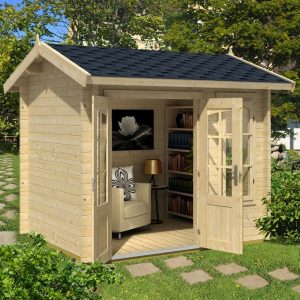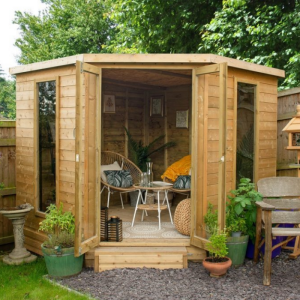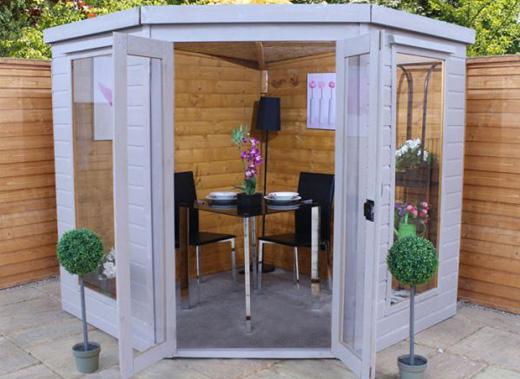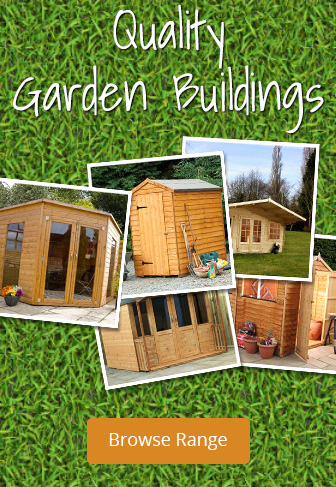Garden Buildings for Small Spaces
Think of a garden and you probably imagine an image of a nice sweeping lawn, abundant flower beds overflowing with plants and bushes, and plenty of room for a babbling brook, stream or water feature. Doesn’t it sound lovely?
While it does indeed sound appealing, many of us have a far smaller garden to make the most of. Maybe your garden isn’t very wide, or it is far shorter than you’d like it to be. Maximising the available space is vital if you’re going to get the best from every square inch of it.
The limitations posed by a small garden
When you have a big garden, you can do almost anything with it. You can add a decking area, a pond, a shed, a summer house… whatever you want to do, it’s probably possible. Providing, of course, it’s within your budget.
A small garden is more challenging, though. Chances are, you won’t have room to accommodate everything you would like to have. Some things may have to be scaled down dramatically to be fitted in at all. And the last thing you want is for your garden to look cluttered.
There’s a fine line between having a nice space to use and appreciate, and having a small garden that is woefully overcrowded.
Can you overcome your small garden frustrations?
You can – and it starts with a good plan. Use some squared paper to mark out the exact dimensions of your plot to scale. Add in fences, walls and gates – anything you’re not going to move.
Do you have trees and bushes already present? Consider whether you want to keep them for shade and screening, or whether they take up too much room and would be better off removed.
Next, think about what you want to achieve with your space. Even the smallest garden can be made more interesting and cosy with good planting, perhaps with the addition of some raised beds. Getting rid of the lawn and laying gravel or decking can minimise the amount of work needed to maintain your garden, too.
But what about adding a garden building? Surely you don’t have enough room for one of those?
The advantages of owning a corner log cabin or corner summer house

Smaller plots benefit from corner-based garden buildings. They make the most of the space available while still offering superb entertaining possibilities. Corner designs are less imposing than traditional square or rectangular designs, which means you can still enjoy the many benefits a garden building offers, even when you’re short on space.
Look at the Greenway 2.5m x 2m mini Elizabeth log cabin, for example. Can you really squeeze a log cabin into your plot? This example shows it could well be possible. The door is placed at the cut-off corner of the cabin, while the roof takes up the entire square. This opens up your garden a little more while providing you with a chance to enjoy a nice cosy spot for casual dining or simply resting and relaxing.
Another option to consider is a corner summer house. If you go for one with large windows and fully-glazed double doors as well, you’ll minimise the effect it has on the space, while still maximising the size of the summer house itself. You’ll see what we mean when you take a look at the Adley 7’ x 7’ Chelsea corner summer house. You can even add a free wood treatment to your order if you opt for this model. Alternatively, if you want a choice of more colour finishes, choose another wood treatment option for a small additional fee. A lighter shade would help make the corner summer house look less imposing on the surrounding area.

If you’d rather have half-glazed doors on your new summer house, maybe the Hartwood 8' x 8' Eton Corner Summer House would fit the bill. This features a window on either side of the double door corner entrance, and they all have a nice curved feature to the top of the glass panels. There’s ample room for two chairs and a table in this summer house, so you can use it as a nice nook or refuge whenever you need to recharge your batteries.
With so many options to consider, you can see it might be easier than you originally imagined to fit a corner summer house or corner log cabin into the smallest of plots. While it is always important to measure up first, the addition of a small garden building of this type can make a small garden far more appealing. It’s up to you to decide how it might fit in with the rest of your garden, but you can see how much there is to think about. So… what will you do with your small garden?



